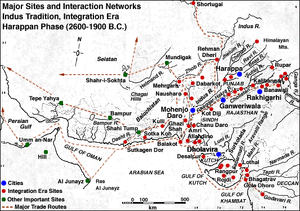Rehman Dheri
| Author:Laxman Burdak, IFS (R) |

Rehman Dheri or sometime Rahman Dheri (Hindi:रहमान ढेरी), Urdu = رحمان ڈھیری) is a Pre-Harappan Archaeological Site situated near Dera Ismail Khan in the Khyber Pakhtunkhwa province of Pakistan. It is a site of Indus Valley Civilization.
Location
This is one of the oldest urbanised centres found to date in South Asia. Dated about 4000 BC, the site is situated 22 kms north of Dera Ismail Khan.
Site of Indus Valley Civilization
Since the earliest occupation, except for the extension outside the city in the south, the entire habitation area was enclosed by a massive wall, built from dressed blocks made from clay slabs. [1] The low mound of this fortified town is visible from Bannu Road. This rectangular mound is covering about 22 hectares and standing 4.5 m above the surrounding field. The fortified town of about ten to fifteen thousand inhabitants shows sign of town planning. Pottery, and stone and metal tools were found.
No seals were found and no writing was discovered, though some forms of engraving or scraping on the pottery were observed.
From Bannu Road the low mound of this fortified town can easily be seen. The ultimate professional phase of the place is clearly visible on the surface of the mound by eye and even through air photographs. This mound is rectangular is shape with a grid iron network of boulevard and path that divides the path into rectangular blocks. In the early morning or after the rain the walls demarcating individual buildings and avenue frontages are clearly visible and it’s easy to recognize the site of a number of small-scale industrial areas within the site is marked as it is an eroded kilns and scatters of slags.
In Rehman Dehri the archeological sequence is over 4.5 meters deep and it covers a series of over 1,400 years that was begun at c. 3,300 BC. Reham Dehri characterizes different periods which includes the period from c. 3300-2850 BC, c. 2850-2500 BC, and the last is from c. 2500-1900 BC.
In its earliest phases it is accepted that the settlement receives its formal planning and that consequent stages extended the plan over time. Even though the excavators have cut a number of deep trenches into the lower levels, the uncovered area was too limited to study the spatial sharing of craft activities.
In the middle of the third millennium BC, at the beginning of the mature Indus phase, the site was abandoned. There was limited reoccupation.
Some more records are found at the neighbouring archaeological mound Hisam Dheri.
Due to the recent developments, the plans of the Early Harappan settlement were disturbed.
This site represents the earliest urban settlement on the sub-continent, with a very rich bead industry. It was earlier than the Kot Diji complex.[2]
External links
References
- ↑ Hasan, Shaikh Khurshid (2005) Historical Forts in Pakistan, National Institute of Historical & Cultural Research, Centre of Excellence, Quaid-i-Azam University, Islamabad. ISBN 969-415-069-8
- ↑ Charles Keith Maisels, Early Civilizations of the Old World: The Formative Histories of Egypt, The Levant, Mesopotamia, India and China. Routledge, 2003 ISBN 1134837305
Back to Indus Valley Civilisation

